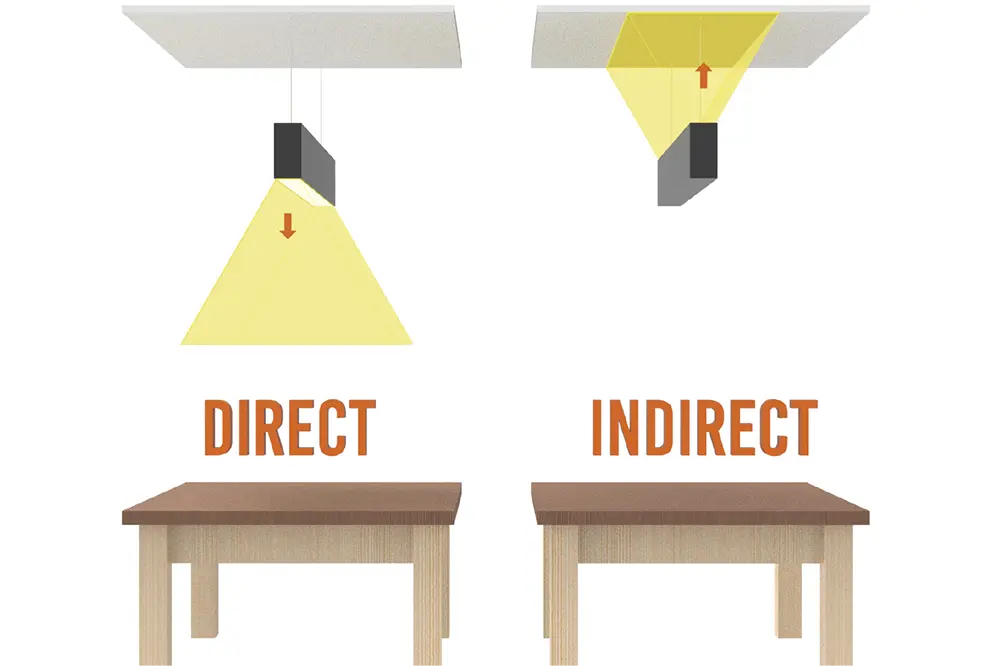In the realm of interior design, the choice between direct lighting vs indirect lighting can dramatically transform a space, influencing both its aesthetic appeal and functionality. Imagine entering a room where the lighting is perfectly balanced, creating an inviting atmosphere that highlights every detail without overwhelming the senses. This is the power of understanding and implementing the right lighting strategy, a crucial element that can elevate any environment from ordinary to extraordinary.
Lighting is not merely a functional necessity; it is a pivotal factor that affects mood, productivity, and even health. Studies have shown that 68% of employees are dissatisfied with their office lighting, which can lead to decreased productivity and increased stress. This statistic underscores the importance of selecting the appropriate type of lighting for different settings, whether it’s a cozy living room or a dynamic workspace. By understanding the nuances between direct and indirect lighting, you can create spaces that not only look beautiful but also enhance well-being.
As we delve into this comprehensive guide, you’ll discover the unique characteristics of direct and indirect lighting, their respective benefits, and practical tips for their application. Whether you’re a homeowner seeking to enhance your living area or a professional aiming to optimize a workspace, this guide will illuminate the path to achieving the perfect lighting balance. Join us as we explore how to make informed lighting choices that will transform your spaces and enrich your everyday experiences.
What is Direct Lighting?
Direct lighting brightly illuminates specific areas.
This form of lighting occurs when the light source shines directly on an area, permitting no interference or diffusion of light. The primary advantage of direct lighting is that it provides concentrated and often vigorous illumination in a targeted manner, allowing for enhanced visibility and focus. Typically, direct lighting is employed in workspaces or areas that require precise lighting, like kitchen counters or office desks, where clarity and attention are crucial.
The essence of direct lighting lies in its purposeful focus.
It is a deliberate choice for spaces where high visibility is essential – from highlighting fine details in art pieces to ensuring tasks are completed with greater accuracy and safety. Direct lighting truly excels when used strategically, fostering vibrant settings.
An inspiring forward-thinking vision for direct lighting harnesses innovative lighting technologies to create more sustainable spaces, ensuring that by the time our designs reach their new year advancements, they embody not just functionality, but also a commitment to energy efficiency. This vision illustrates how illumination can be both practical and inspiring, enhancing spaces while reflecting a conscientious awareness of our environment’s needs.
What is Indirect Lighting?
Indirect lighting artfully diffuses light across a space, enhancing the ambience with a gentle, welcoming glow. By softly illuminating an area, it transforms environments into serene sanctuaries without harsh glare or shadows.
Strategically placed fixtures or reflective surfaces are often used for indirect lighting.
These surfaces bounce the light, spreading it evenly and creating a harmonious environment.
This approach not only enhances aesthetic value but also reduces eyestrain, promoting a comfortable viewing experience.
By leveraging the interplay of light and space, indirect lighting seamlessly integrates with architectural elements, adding depth and dimension, reminiscent of nature’s soft, glowing radiance that elevates any setting beyond illumination alone.
Ultimately, the beauty of indirect lighting’s allure is found in its ability to enrich spaces. It uplifts our surroundings, making them feel more expansive and tranquil, celebrating the subtleties of light’s nuanced grace.
Comparing Direct Lighting vs Indirect Lighting
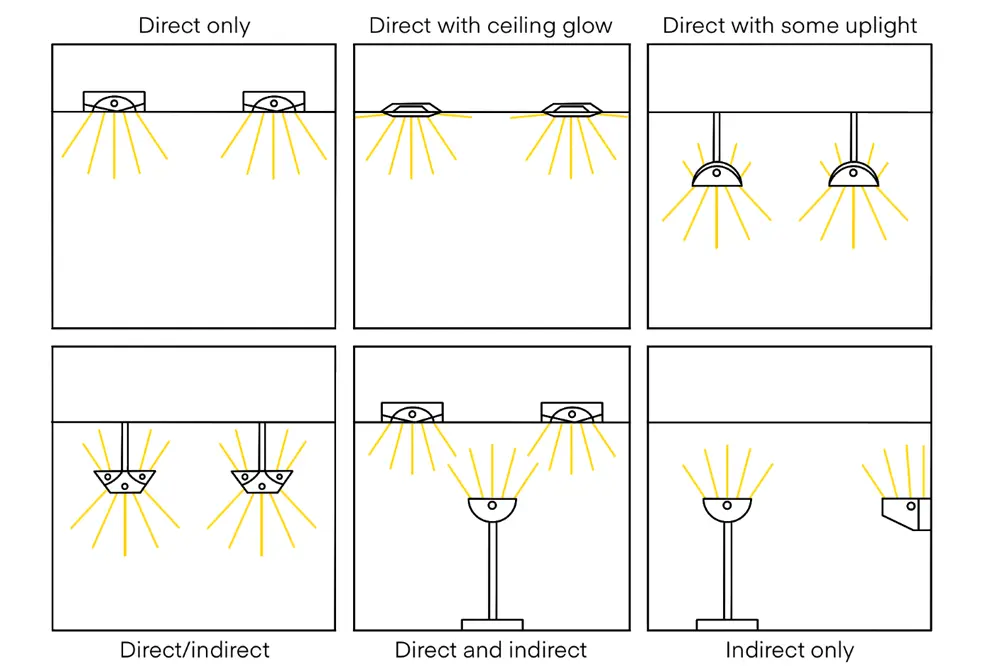
Delving into the world of lighting design, one uncovers a dynamic interplay of illumination strategies, where direct and indirect lighting emerge as formidable allies, each wielding distinct characteristics to shape our environments.
Direct lighting features light beaming directly towards a specific area, offering precise illumination.
Conversely, indirect lighting disperses light, enveloping spaces in a gentle glow, minimizing glare and shadows.
In essence, direct lighting is ideal for task-oriented functions, illuminating workspaces with clarity and precision.
Indirect lighting, however, excels in creating atmospheric environments, enhancing spatial perception and supporting relaxation, with its subtle diffusion mimicking natural light’s calming properties.
Ultimately, the harmonious blend of both styles transforms spaces into multifunctional havens, allowing for a reflection of one’s design sensibilities. Thoughtfully integrating direct and indirect lighting can maximize aesthetic appeal while ensuring practical functionality.
Benefits of Direct Lighting
Direct lighting stands as an unparalleled choice for precision-focused tasks, offering crisp illumination that enhances productivity and concentration, whether one is reading, writing, or crafting meticulous projects.
Clarity and focus flourish under direct lighting, transforming workspaces into hubs of creativity.
Direct lighting’s targeted nature ensures essential areas receive concentrated illumination, fostering an environment where accuracy is paramount. It provides a solid foundation for meticulous tasks required in industries that demand meticulous attention to detail, such as design, engineering, or medical fields.
Moreover, its adaptability in modern lighting solutions empowers users to cast light precisely where needed, be it through adjustable lamp heads or strategic fixture placements. This lighting type excels in transforming any workspace into a tailored experience, making every detail palpable and every color vibrant. By embracing direct lighting, individuals cultivate spaces that are not only functional but also inspired, where idea generation and execution seamlessly intertwine.
Benefits of Indirect Lighting
Intriguingly, indirect lighting offers substantial benefits that enhance the ambiance and comfort of interior spaces.
In recent years, renowned psychologist, Dr. Eleanor King, highlighted how gentle lighting enhances relaxation and reduces stress levels, thereby improving overall wellbeing. The soft diffusion of light minimizes harsh shadows and glare, creating a serene environment that promotes tranquility and mental clarity.
Indirect lighting also allows for design flexibility. It transforms a space’s aesthetic by subtly highlighting architectural features and augmenting the interplay of light and shadow, which brings warmth and depth to any room. This illumination technique is exceptionally effective at creating an inviting atmosphere that beckons calmness and contemplation.
Besides its impact on mood, indirect lighting is often more energy-efficient, as it maximizes the use of available luminance. Lights installed close to ceilings or walls distribute light evenly, enabling lower light levels that achieve the desired effect with less energy usage. The sustainability and cost-effectiveness marry beautifully with the modern eco-conscious sensibilities of today’s design aesthetics.
In essence, the benefits of indirect lighting manifest in emotional, economic, and aesthetic enhancements that uplift any space.
Direct Lighting in the Home
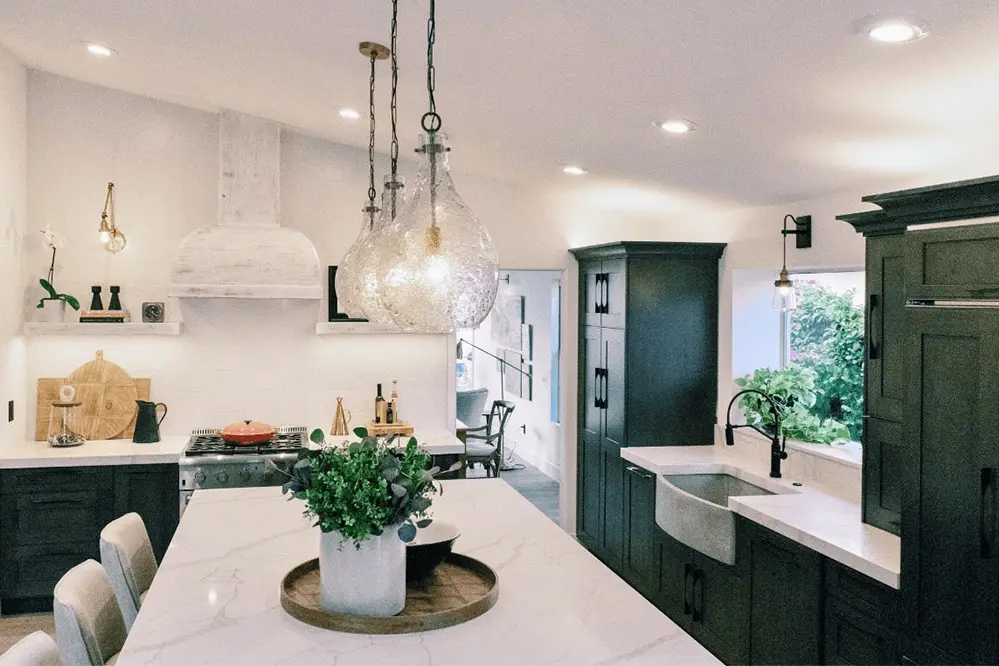
Direct lighting is all about precision.
When used right, direct lighting can guide every task. The main advantage of direct lighting in the home lies in its ability to perform specific functions, such as illuminating work surfaces, reading areas, or kitchen islands, where focus is key. Strategically placed, it can be the unsung hero of productivity by reducing strain during visually intense activities.
The clarity provided by direct lighting enhances vision.
Imagine the brilliance of targeted light beams – like the kind that might spill over a cozy reading nook or brightly illuminate countertops in the kitchen – offering unparalleled control and utility. It’s about harnessing illumination where it matters most, accentuating the necessity of light in specific areas.
By combining functional elegance with modern flair, direct lighting becomes a cornerstone of contemporary interior design, perfectly aligning with the sleek, efficient homes of the new year era. Such illumination not only serves a practical purpose but also enriches the character of each room, boldly emphasizing focal points and establishing a foundation of refined sophistication.
Indirect Lighting in the Home
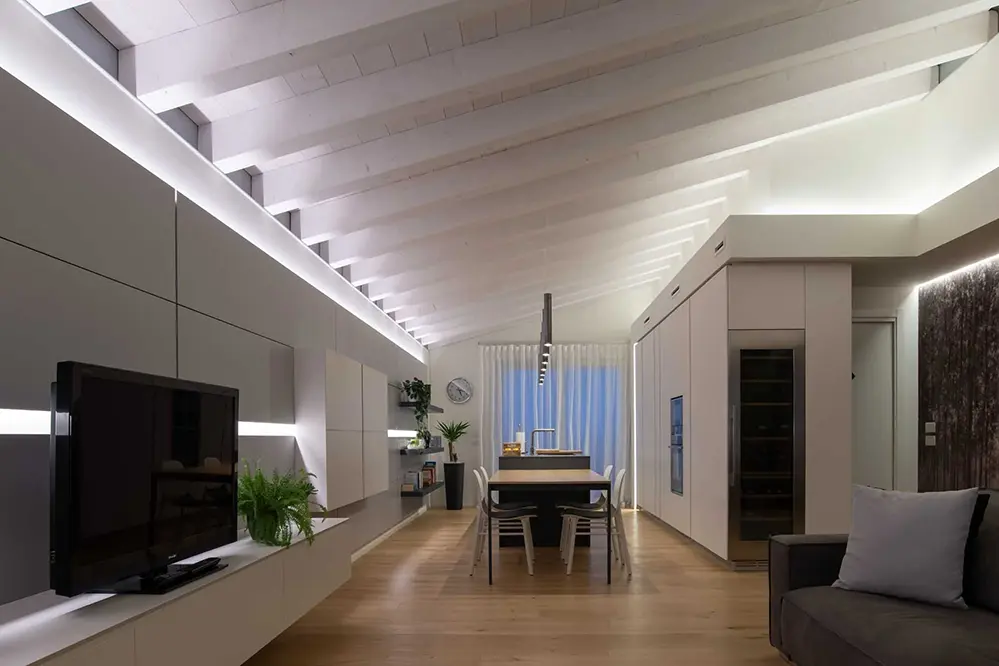
Indirect lighting is an extraordinary method, often overlooked, that transforms your living experience with subtle elegance and comfort.
In the world of interior design, indirect lighting serves as a harmonizing backdrop, softening harsh textures, and enveloping spaces in a gentle glow. By redirecting light upwards or towards walls, this approach minimizes glare and maximizes comfort – perfect for creating a serene, inviting atmosphere conducive to relaxation and conversation.
Typically, these lights are housed in sconce fixtures or hidden within coves and valances. They bathe walls and ceilings in a warm, even light that quietly enhances the aesthetic appeal of your living space without overwhelming it, offering a soothing backdrop for daily activities and intimate gatherings.
Ingeniously, indirect lighting allows for an adaptable design canvas that offers versatility and creativity, by highlighting architectural nuances while creating an ambient scene that’s both immersive and comforting. It underscores the art of living well, marrying functional peace with stylistic harmony, ultimately elevating everyday experiences into exceptional moments of inspiration and solace.
Best Uses for Direct Lighting
Direct lighting, with its focused intensity, serves as a powerful tool for illuminating key areas and enhancing specific tasks.
In workspaces, the precise illumination offered by a directional spotlight or desk lamp enhances productivity, ensuring that intricate tasks, such as reading and writing, are executed with ease and minimal strain. This type of lighting is also ideal for kitchens, where it casts a clear, concentrated light over countertops, making food preparation safer and more efficient.
Furthermore, direct lighting excels at accentuating the beauty of artwork or highlighting architectural features. By applying a focused beam, one can create dramatic visual interest and guide attention precisely, offering an artistic flourish that elevates any space.
In retail environments, the strategic placement of direct lighting can significantly influence consumer behavior, by illuminating products in a way that accentuates their best features. This targeted approach to lighting not only enhances visual appeal but also fosters an inviting and engaging shopping experience, ultimately driving customer engagement and satisfaction.
Best Uses for Indirect Lighting
Indirect lighting offers a gentle, harmonious ambiance that enhances the aesthetic quality of any space, creating an inviting warmth that envelops occupants in comfort. Its ability to diffuse light evenly eliminates harsh shadows and glare, making it a perfect choice for the hospitality industry.
This lighting strategy works wonders in the home, where one desires a serene atmosphere.
Living rooms, lounge spaces, and bedrooms benefit greatly from soft, ambient light (commonly implemented through cleverly concealed fixtures). Indirect lighting imbues these areas with an understated elegance that encourages relaxation.
This subtle illumination method is ideal for commercial spaces like offices and conference rooms, promoting focus without inducing fatigue. Indirect lighting fosters an environment that is both professional and comforting.
Moreover, indirect lighting is indispensable when illuminating hallways, where it spreads warm light, providing an understated guide whilst doubling as architectural flare, thus enhancing spatial perception with grace.
Ultimately, the aim of employing indirect light isn’t just about illumination. Rather, indirect lighting creates layers of visual interest, enriching environments through soothing, enveloping light.
Choosing Between Direct and Indirect Lighting
Choosing the right lighting involves understanding the nuances between direct and indirect lighting. Why does this matter?
In recent years, Sarah Newland, a renowned lighting designer, emphasized that lighting isn’t merely about illuminating spaces but about crafting experiences that resonate with the intended mood and function.
Now, let’s dive into what makes these lighting options unique and how selecting the right type of lighting can transform your environments and elevate your mood and productivity.
Considering the size of the room and the purpose it serves, one can make calculated decisions. Whether it’s the intimate ambiance of a dining area or the focused intensity of a reading nook, the particular characteristics that direct and indirect lighting embody can be cleverly leveraged to achieve desired outcomes.
A conscious choice between these two options ensures the atmosphere reflects your desired style and functionality.
Combining Direct and Indirect Lighting
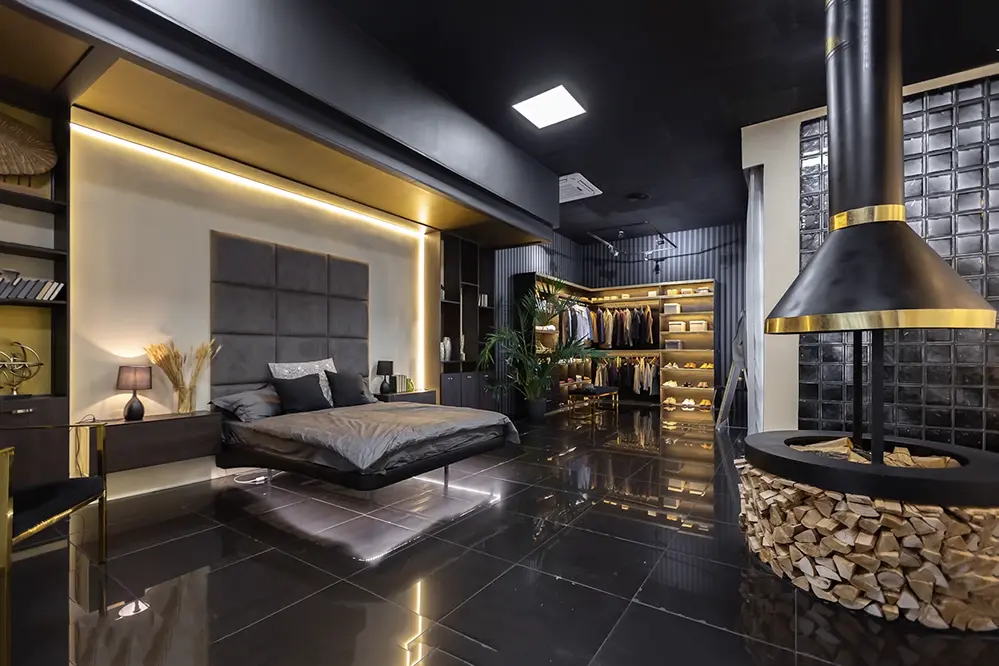
Blending direct and indirect lighting offers remarkable opportunities to enhance the ambiance and functionality of various spaces.
The symphony of these two lighting types creates a harmonious environment tailored to the needs and aesthetics of any setting. The interplay of light can foster different atmospheres, reflecting personal tastes while maintaining practical illumination.
Consider the elegance of combining both in a living room, where strategic placement of indirect lighting softens the space’s edges, while a direct light fixture illuminates focal points like artwork or bookcases. This collaboration seamlessly merges utility with beauty.
Incorporating this balanced lighting design rewards spaces with versatility, enabling transformations from vibrant party venues to serene retreats with a simple switch. Recognizing the strengths of each lighting type empowers you to creatively merge them into artful compositions.
With imagination and strategy, combining both lighting forms crafts extraordinary spaces that adapt to every occasion and mood.
Common Mistakes to Avoid
Navigating the realm of lighting design requires attentiveness to avoid common pitfalls that can detract from the essence of space.
One prevalent mistake is the overuse of direct lighting, which can lead to harsh environments devoid of warmth. Over-reliance on direct light may create glares, potentially resulting in discomfort and visual fatigue for the occupants.
Conversely, exclusively using indirect lighting can produce shadows and require numerous fixtures to achieve adequate light levels, increasing complexity and potentially cluttering the aesthetic.
Integrating these types thoughtfully ensures balance; evaluate the function and mood of each space carefully and allocate lighting sources accordingly, aligning with your desired ambiance and utility.
Ultimately, the goal is to harmonize functionality with design, avoiding these missteps to cultivate enduring, vibrant atmospheres that enhance every interaction.
Cost Considerations for Lighting Options
Choosing between direct and indirect lighting requires a keen understanding of cost implications, which encompass materials, energy consumption, and maintenance. Each lighting type offers distinct advantages that could influence your decision significantly.
Direct lighting typically incurs lower initial costs due to fewer fixtures needed. However, these savings might be offset by higher energy consumption.
Indirect lighting, on the other hand, often requires more fixtures, which increases upfront costs. Nevertheless, these systems usually utilize energy-efficient technologies that can reduce operational expenses.
When deliberating on long-term financial impact, consider energy efficiency of light sources, reassessing conventional bulbs for LED alternatives. Energy-efficient options frequently present favorable return on investment by lowering utility bills.
Additionally, think about maintenance costs, as installing indirect lighting may necessitate more frequent bulb replacements. Nonetheless, indirect lighting systems can offer longer lifespan, mitigating these additional expenses over time.
Finally, focus not just on what’s immediate but on what’s truly sustainable. Smart technology investment choices will ensure an environment with optimal light without breaking the bank.
Conclusion
Direct and indirect lighting each bring unique benefits that cater to specific needs, whether you’re aiming for energy efficiency or creating a particular ambiance. The choice between direct lighting vs indirect lighting should align with your goals, taking into account both the impact on utility bills and the atmosphere you wish to cultivate.
Harnessing the power of lighting requires thoughtful consideration and a customized approach for every space and setting. By skillfully combining the strengths of both lighting types, you can create environments that are not only functional but also inviting and energy-savvy. This approach ensures that each space is optimized for its intended use while maintaining aesthetic appeal.
Embracing the complexities of direct and indirect lighting enhances modern living. As we stand at the forefront of new year’s lighting innovations, integrating sophisticated designs reflects our commitment to intelligent solutions. This journey toward optimal lighting solidifies our progress and elevates our perspective on creating spaces where both efficiency and beauty thrive.
